Hunting Tips, Questions, Stories & Discussion
Focusing on managing Texas wildlife habitat and natural resources for native and exotic wild game species, for this and future generation of hunters and outdoor enthusiasts.Thursday, November 19, 2009
Hunting the Nocturnal Feral Hog
It was Friday night on November 13th, 2009. I arrived at Escondido Ranch earlier that afternoon with a mission to help eradicate spikes, hogs and other genetically inferior whitetails off of the ranch. Needless to say, I was ready for the challenge. Over dinner, Kurt, Tony and I spoke about the brazen numbers of hogs captured on 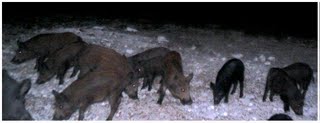 trail cams during the wee hours of the morning (1-3 am). I volunteered to get everyone up at the right hour to increase our chances of success…to which I received unenthusiastic responses. I guess those guys needed their beauty sleep. Oh well… Therefore, since the dirty deed still needed to be done, shortly after dinner, around 9 pm, we jumped into Escondido’s vintage military jeep modified with elevated back row seats and a cross-bar shooting support, and went out on an evening of spotlighting. Kurt was at the helm, Tony was operating the spotlight and I was the designated shooter; perched along with Tony on the back row.
trail cams during the wee hours of the morning (1-3 am). I volunteered to get everyone up at the right hour to increase our chances of success…to which I received unenthusiastic responses. I guess those guys needed their beauty sleep. Oh well… Therefore, since the dirty deed still needed to be done, shortly after dinner, around 9 pm, we jumped into Escondido’s vintage military jeep modified with elevated back row seats and a cross-bar shooting support, and went out on an evening of spotlighting. Kurt was at the helm, Tony was operating the spotlight and I was the designated shooter; perched along with Tony on the back row.
We ran into a technical problems a few moments after the departure. The spotlight kept flickering on and off. After fidgeting with it for a few moments, we determined that the problem was with the broken wiring inside the casing. Nonetheless, Tony managed to keep the spotlight “on”, while Kurt took a path “less traveled” along one of the back roads crisscrossing Escondido's terrain.
As the powerful beam skirted past the brush line, it illuminated multiple pairs of eyes staring back. With the unusually high amounts of rainfall this year, there was an abundance of natural vegetation throughout South Central Texas. All the native and exotic animals on the ranch, from axis to whitetail deer, sika and fallow, along with elk, aoudad and feral hogs gorged on the natural buffet during the night and stayed hidden during daylight hunting hours. So, it was refreshing to see so many animals glaring back at us from beneath the shadows of the underbrush.
Kurt took a hard left and we found ourselves on a road leading to Betty’s blind. As the vehicle swung around, on the fringes of the light, we caught a glimpse of a backside of a large, feeding animal standing just a few yards ahead us. “It’s a hog!”, I exclaimed, as the animal heard our approaching jeep and jolted forward. Someone started to say something about a sika deer, but then Tony zeroed in on the moving animal and we could all see the corkscrew tail of a hog. The shadowy figure dashed from left to right as it tried to stay ahead of the trailing beam of light.
Kurt brought the vehicle to an immediate stop. I lifted the rifle and locked the bolt into place. Quickly resting the .270 across the shooting bar, I looked over the top of the scope trying to anticipate the hog’s next move. As I swung the rifle along the path of the fleeing animal, I spotted its backside in the scope as the hog quartered away from me. In a split moment, I decided to try to stop the animal before it reached the safety of the brush and squeezed the trigger. Shot rang out…and then everything went black…
Apparently, the faulty floodlight turned "off" when Tony, in an attempt to preserve his hearing, stuck his fingers into his ears. Kurt was barely able to do the same before I pulled the trigger.
Then, before anyone had a chance to ask THE question, we heard the not too distant squealing of a mortaly wounded animal. By then, Tony was able to re-engage the contacts and point the revived beam in the direction of the hog. As the light cut through the veil of darkness, a large, black boar came into focus.
The animal was feverishly digging its front hooves into the ground while frantically swinging its-714179.jpg) head from side-to-side in a feeble attempt to jolt its backside forward. It quickly became apparent that the first shot broke the hog’s back. But before we could safely approach it, the hog needed to be put-down. Since the head of the hog was swaying from side to side, I took aim at the heart and pulled the trigger. The boar first dropped to the ground, but then surprisingly, reared back up on its front legs. The final, head shot, put it down for good.
head from side-to-side in a feeble attempt to jolt its backside forward. It quickly became apparent that the first shot broke the hog’s back. But before we could safely approach it, the hog needed to be put-down. Since the head of the hog was swaying from side to side, I took aim at the heart and pulled the trigger. The boar first dropped to the ground, but then surprisingly, reared back up on its front legs. The final, head shot, put it down for good.
A few moments later we backed up the jeep to the boar and had a clear look at the expired animal. This was certainly not the largest feral hog taken on Escondido Ranch and most likely not the biggest one currently residing there, but at just under 200 pounds this was an impressive specimen, nonetheless.
We loaded the animal into the jeep and cruised down to the cleaning station in the valley below, along the way recounting the pure excitement of the hunt. The smooth execution by the Hog Tag Team made this hunt exciting and productive!
The meat from the hog was donated to the Wild Game Charity Dinner, while the skull will most likely grace one of the walls at Escondido Ranch.
 trail cams during the wee hours of the morning (1-3 am). I volunteered to get everyone up at the right hour to increase our chances of success…to which I received unenthusiastic responses. I guess those guys needed their beauty sleep. Oh well… Therefore, since the dirty deed still needed to be done, shortly after dinner, around 9 pm, we jumped into Escondido’s vintage military jeep modified with elevated back row seats and a cross-bar shooting support, and went out on an evening of spotlighting. Kurt was at the helm, Tony was operating the spotlight and I was the designated shooter; perched along with Tony on the back row.
trail cams during the wee hours of the morning (1-3 am). I volunteered to get everyone up at the right hour to increase our chances of success…to which I received unenthusiastic responses. I guess those guys needed their beauty sleep. Oh well… Therefore, since the dirty deed still needed to be done, shortly after dinner, around 9 pm, we jumped into Escondido’s vintage military jeep modified with elevated back row seats and a cross-bar shooting support, and went out on an evening of spotlighting. Kurt was at the helm, Tony was operating the spotlight and I was the designated shooter; perched along with Tony on the back row.We ran into a technical problems a few moments after the departure. The spotlight kept flickering on and off. After fidgeting with it for a few moments, we determined that the problem was with the broken wiring inside the casing. Nonetheless, Tony managed to keep the spotlight “on”, while Kurt took a path “less traveled” along one of the back roads crisscrossing Escondido's terrain.
As the powerful beam skirted past the brush line, it illuminated multiple pairs of eyes staring back. With the unusually high amounts of rainfall this year, there was an abundance of natural vegetation throughout South Central Texas. All the native and exotic animals on the ranch, from axis to whitetail deer, sika and fallow, along with elk, aoudad and feral hogs gorged on the natural buffet during the night and stayed hidden during daylight hunting hours. So, it was refreshing to see so many animals glaring back at us from beneath the shadows of the underbrush.
Kurt took a hard left and we found ourselves on a road leading to Betty’s blind. As the vehicle swung around, on the fringes of the light, we caught a glimpse of a backside of a large, feeding animal standing just a few yards ahead us. “It’s a hog!”, I exclaimed, as the animal heard our approaching jeep and jolted forward. Someone started to say something about a sika deer, but then Tony zeroed in on the moving animal and we could all see the corkscrew tail of a hog. The shadowy figure dashed from left to right as it tried to stay ahead of the trailing beam of light.
Kurt brought the vehicle to an immediate stop. I lifted the rifle and locked the bolt into place. Quickly resting the .270 across the shooting bar, I looked over the top of the scope trying to anticipate the hog’s next move. As I swung the rifle along the path of the fleeing animal, I spotted its backside in the scope as the hog quartered away from me. In a split moment, I decided to try to stop the animal before it reached the safety of the brush and squeezed the trigger. Shot rang out…and then everything went black…
Apparently, the faulty floodlight turned "off" when Tony, in an attempt to preserve his hearing, stuck his fingers into his ears. Kurt was barely able to do the same before I pulled the trigger.
Then, before anyone had a chance to ask THE question, we heard the not too distant squealing of a mortaly wounded animal. By then, Tony was able to re-engage the contacts and point the revived beam in the direction of the hog. As the light cut through the veil of darkness, a large, black boar came into focus.
The animal was feverishly digging its front hooves into the ground while frantically swinging its
-714179.jpg) head from side-to-side in a feeble attempt to jolt its backside forward. It quickly became apparent that the first shot broke the hog’s back. But before we could safely approach it, the hog needed to be put-down. Since the head of the hog was swaying from side to side, I took aim at the heart and pulled the trigger. The boar first dropped to the ground, but then surprisingly, reared back up on its front legs. The final, head shot, put it down for good.
head from side-to-side in a feeble attempt to jolt its backside forward. It quickly became apparent that the first shot broke the hog’s back. But before we could safely approach it, the hog needed to be put-down. Since the head of the hog was swaying from side to side, I took aim at the heart and pulled the trigger. The boar first dropped to the ground, but then surprisingly, reared back up on its front legs. The final, head shot, put it down for good.A few moments later we backed up the jeep to the boar and had a clear look at the expired animal. This was certainly not the largest feral hog taken on Escondido Ranch and most likely not the biggest one currently residing there, but at just under 200 pounds this was an impressive specimen, nonetheless.
We loaded the animal into the jeep and cruised down to the cleaning station in the valley below, along the way recounting the pure excitement of the hunt. The smooth execution by the Hog Tag Team made this hunt exciting and productive!
The meat from the hog was donated to the Wild Game Charity Dinner, while the skull will most likely grace one of the walls at Escondido Ranch.
Labels: texas feral hog hunts, wild boar hunts, wild hog hunting
Monday, September 14, 2009
Hunting Report - September 6, 2009
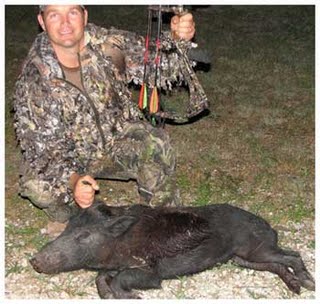 The evening hunt started out pretty slow with only a few animals moving due to the heat and humidity, and, in part, to the recent rain. I was perched in my bow stand in an old oak tree about 15 feet off the ground. The stand itself is situated between two canyons. One of my favorite hunting places on the ranch. I was ready to shoot a wild hog or a young aoudad sheep if they were willing to cross my path. As the late evening progressed, I spied on several young whitetail bucks that were just passing through looking for place to graze. The whitetail buck population with the abundant rains and supplemental year-round feed looks especially strong this year at Escondido Ranch.
The evening hunt started out pretty slow with only a few animals moving due to the heat and humidity, and, in part, to the recent rain. I was perched in my bow stand in an old oak tree about 15 feet off the ground. The stand itself is situated between two canyons. One of my favorite hunting places on the ranch. I was ready to shoot a wild hog or a young aoudad sheep if they were willing to cross my path. As the late evening progressed, I spied on several young whitetail bucks that were just passing through looking for place to graze. The whitetail buck population with the abundant rains and supplemental year-round feed looks especially strong this year at Escondido Ranch.It was about 7:00 P.M. when my first potential prey decided to show itself. First, two Aoudad sheep, each with about 20 inches of horn, peeked out from the brush. Not trophy class, but not good eating size either. Aoudad sheep taste better when they are harvested at a younger age. Twelve inches of horn or less is a good reference length for eating purposes. With that in mind I decided to pass. Just a few moments later, two wild hogs surfaced along the brush line. I got into position and waited for the hogs to clear from behind an overhanging tree limb blocking my shooting lane. As the hog moved into a clearing, I became a bit anxious due to the amount of time I had to think about my shot. As I drew my bow to full draw, I set my 20 yard pin sight on the vital organs of the larger of the two wild boars. In a fleeing moment, my arrow screamed through the humid south Texas air and hit the boar on the side, passing through and leaving an exit hole the size of a golf ball. I did it!! The hog ran immediately into the brush and expired briefly thereafter. Well thanks for reading and check out EscondidoRanch.com for all your hunting wants and desires.
Labels: bow hunting, texas boar hunting, texas feral hog hunts, wild hog hunting
Thursday, July 9, 2009
Hunting Report: July 4, 2009
It was a cool, low 70s, Saturday morning on July 4th (cool by South Central Texas standards). I parked the truck about 400 yards down the road and proceeded to Betty's blind (affectionately named after Escondido's gracious hostess). The wind was favorable and blowing 5-10 mph parallel to the ground blind and the feeder. The feeder is located 85 yards away from the blind near the wooded edge of a rocky slope leading several hundred feet to a spring below. This time of the year, South Central Texas is scorched by summer heat with day time temperatures hovering over 100 degrees. But earlier in the week, the ranch got 1.5 inches of well received rain and everything was unseasonably green.
It was already close to the shooting light by the time I got into the blind. Today, I was equipped with a 10x44 scope mounted on a brand new .270 rifle and the targets were the feral hog and the illusive aoudad sheep. In the past year, I have been a frequent guest at Escondido Ranch and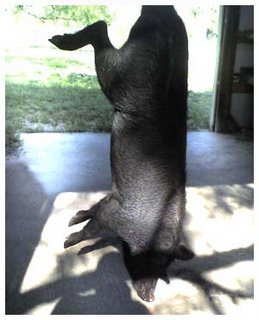 have shot a number of feral hogs. However, in all of my outings at the ranch, I have seen a group of young aoudad sheep only once, at over 200 yards and moving across a narrow opening. There are certainly ample aoudad on the ranch, including a number of trophy animals. A couple of the trophy size mounts are proudly displayed in the main house, but the weary animals continue to elude me.
have shot a number of feral hogs. However, in all of my outings at the ranch, I have seen a group of young aoudad sheep only once, at over 200 yards and moving across a narrow opening. There are certainly ample aoudad on the ranch, including a number of trophy animals. A couple of the trophy size mounts are proudly displayed in the main house, but the weary animals continue to elude me.
I settled in for the morning hunt after practicing a few "air" shots with my rifle to make sure I was in a comfortable shooting position. Even before the feeder went off at 7 am, two whitetail does had made their way across the shooting lane from behind the blind towards the feeder. Both animals passed within 40 yards of me without so much as a second whiff or a cautionary pause, and then proceeded to feed on the green grass around the feeder. The does grazed effortlessly, knowing that they were not on a la carte this morning, and seemed to be oblivious to any accidental noises coming from the blind. A bit later another whitetail and a fallow doe joined the gathering, and proceeded to feed on both the green grass and the corn scattered around by the feeder. The fallow deer, a native of Europe, are also common at Escondido. The fallow bucks are crowned with a set of distinct horns resembling those of a moose, but on a smaller scale. The hides vary in color from pure white (as was this doe) to spotted reddish brown.
The fallow doe was much more alert than the whitetails. As an exotic, the fallow can be hunted year round in Texas. After 15 minutes of nervous feeding, the fallow zigzagged its way toward woods' edge and disappeared in the shadows. Meanwhile the whitetails continued to graze so carefree that one of them approached me to within meager 20 yards (a bow hunters dream).
As the sun ascended in the sky engulfing the tree tops in a brilliant light, I glanced at my watch. Remembering that I promised my wife to be back at the main house by 9am to help with the kids, who came with us for this 4th of July weekend, I decided to call it quits for the morning and started to pack up.
Once packed, with the gun unloaded, I was literally pushing open the door, when all of a sudden, a black feral hog appeared from the brush and trotted directly towards my hideaway. My heart started to pound. I eased the backpack to the floor, felt around my chest pocket for .270 round (130 grain), placed the bullet into the chamber and eased the bolt into the position. Thirty yards out, the hog stopped, lifted up its snout and sniffed the air with authority, grunting a couple of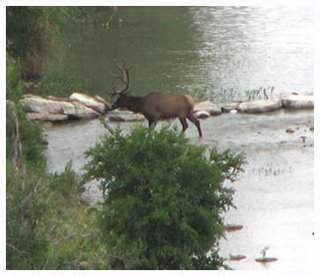 times in the process. Meanwhile, the three whitetail does stopped feeding and intently looked at the hog.
times in the process. Meanwhile, the three whitetail does stopped feeding and intently looked at the hog.
When I finally locked the bolt into place, the inevitable click of the mechanism must have sounded like a ringing bell to the nearby hog, which looked in my direction and quickly turned sideways and began to pick up speed. The rest was a blur... I raised my rifle, somehow found the hog in the scope, instinctively aimed behind the shoulder while thinking that he was too close and does not need to be lead, removed the safety and pulled the trigger.
The shot rang out and through the dissipating cloud of gun smoke, I could see the hog fall on its back and after a few leg twitches rolled over on its side and came to a rest. I jammed another round in the chamber, pushed open the door and quickly walked towards the still hog. It was dead. The bullet entered at a slight angle behind the left shoulder and exited a bit forward on the other side. The projectile slid effortlessly through the heart leaving small entry and exit wounds. The hog never suffered.
It all happened so fast that I did not even have a chance to fully enjoy that fleeting moment when anticipation meets with preparation. Only after the deed was done, did I look down at my hands and they were still shaking from the adrenaline rush. I love it! At that point my cell phone began to vibrate. It was my bow hunting partner Tony, who only two weeks prior harvested another hog with a bow after stalking up on him to within 30 yards. He was checking in about the shot he had heard. Congratulations followed.
After I loaded the hog into the back of the truck, we met up at the cleaning station in the valley below where we proceeded to wager on the weight of the hog. Tony, the country dude that he is,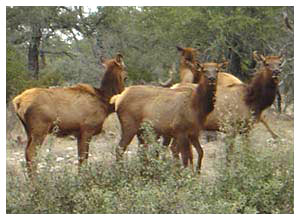 won the bet after estimating the weight at 100 lbs. The hog actually weighed in at 102 lbs. I am glad we did’t have money on it.
won the bet after estimating the weight at 100 lbs. The hog actually weighed in at 102 lbs. I am glad we did’t have money on it.
The ranch manager offered to dress the hog and I jumped on Tony's 4-wheeler and headed back to the main house which is perched on a cliff overlooking the valley and the river. On the way back up the winding dirt roads, I ran across a herd of six bull elk. All of them in velvet were displaying their wide tall crowns which will be in high demand later in the year. Elk, once native to Texas, were pushed north by hunting and the encroachment of human habitat. Now, a herd of over thirty animals thrive at Escondido Ranch. The largest bull elk's 6x6 rack was noticeably taller than the rest of the bulls. It will make a nice trophy later this year.
I was only a few clicks form the main house when a herd of cow elk appeared standing along the side of the road. Eight cows were accompanied by a gorgeous chocolate colored Sika buck (a native of Japan) with a full 8-point spread and an accompanying doe of the same color. The noise of the 4-wheeler spooked the entire group and they trotted away towards the safety of the brush. About the same time, my cell began to vibrate again and it was my wife calling.
It was time for me to get back to the house and help with the kids if I harbored any further hope of any more hunting during this 4th of July visit to Escondido Ranch.
It was already close to the shooting light by the time I got into the blind. Today, I was equipped with a 10x44 scope mounted on a brand new .270 rifle and the targets were the feral hog and the illusive aoudad sheep. In the past year, I have been a frequent guest at Escondido Ranch and
 have shot a number of feral hogs. However, in all of my outings at the ranch, I have seen a group of young aoudad sheep only once, at over 200 yards and moving across a narrow opening. There are certainly ample aoudad on the ranch, including a number of trophy animals. A couple of the trophy size mounts are proudly displayed in the main house, but the weary animals continue to elude me.
have shot a number of feral hogs. However, in all of my outings at the ranch, I have seen a group of young aoudad sheep only once, at over 200 yards and moving across a narrow opening. There are certainly ample aoudad on the ranch, including a number of trophy animals. A couple of the trophy size mounts are proudly displayed in the main house, but the weary animals continue to elude me.I settled in for the morning hunt after practicing a few "air" shots with my rifle to make sure I was in a comfortable shooting position. Even before the feeder went off at 7 am, two whitetail does had made their way across the shooting lane from behind the blind towards the feeder. Both animals passed within 40 yards of me without so much as a second whiff or a cautionary pause, and then proceeded to feed on the green grass around the feeder. The does grazed effortlessly, knowing that they were not on a la carte this morning, and seemed to be oblivious to any accidental noises coming from the blind. A bit later another whitetail and a fallow doe joined the gathering, and proceeded to feed on both the green grass and the corn scattered around by the feeder. The fallow deer, a native of Europe, are also common at Escondido. The fallow bucks are crowned with a set of distinct horns resembling those of a moose, but on a smaller scale. The hides vary in color from pure white (as was this doe) to spotted reddish brown.
The fallow doe was much more alert than the whitetails. As an exotic, the fallow can be hunted year round in Texas. After 15 minutes of nervous feeding, the fallow zigzagged its way toward woods' edge and disappeared in the shadows. Meanwhile the whitetails continued to graze so carefree that one of them approached me to within meager 20 yards (a bow hunters dream).
As the sun ascended in the sky engulfing the tree tops in a brilliant light, I glanced at my watch. Remembering that I promised my wife to be back at the main house by 9am to help with the kids, who came with us for this 4th of July weekend, I decided to call it quits for the morning and started to pack up.
Once packed, with the gun unloaded, I was literally pushing open the door, when all of a sudden, a black feral hog appeared from the brush and trotted directly towards my hideaway. My heart started to pound. I eased the backpack to the floor, felt around my chest pocket for .270 round (130 grain), placed the bullet into the chamber and eased the bolt into the position. Thirty yards out, the hog stopped, lifted up its snout and sniffed the air with authority, grunting a couple of
 times in the process. Meanwhile, the three whitetail does stopped feeding and intently looked at the hog.
times in the process. Meanwhile, the three whitetail does stopped feeding and intently looked at the hog.When I finally locked the bolt into place, the inevitable click of the mechanism must have sounded like a ringing bell to the nearby hog, which looked in my direction and quickly turned sideways and began to pick up speed. The rest was a blur... I raised my rifle, somehow found the hog in the scope, instinctively aimed behind the shoulder while thinking that he was too close and does not need to be lead, removed the safety and pulled the trigger.
The shot rang out and through the dissipating cloud of gun smoke, I could see the hog fall on its back and after a few leg twitches rolled over on its side and came to a rest. I jammed another round in the chamber, pushed open the door and quickly walked towards the still hog. It was dead. The bullet entered at a slight angle behind the left shoulder and exited a bit forward on the other side. The projectile slid effortlessly through the heart leaving small entry and exit wounds. The hog never suffered.
It all happened so fast that I did not even have a chance to fully enjoy that fleeting moment when anticipation meets with preparation. Only after the deed was done, did I look down at my hands and they were still shaking from the adrenaline rush. I love it! At that point my cell phone began to vibrate. It was my bow hunting partner Tony, who only two weeks prior harvested another hog with a bow after stalking up on him to within 30 yards. He was checking in about the shot he had heard. Congratulations followed.
After I loaded the hog into the back of the truck, we met up at the cleaning station in the valley below where we proceeded to wager on the weight of the hog. Tony, the country dude that he is,
 won the bet after estimating the weight at 100 lbs. The hog actually weighed in at 102 lbs. I am glad we did’t have money on it.
won the bet after estimating the weight at 100 lbs. The hog actually weighed in at 102 lbs. I am glad we did’t have money on it.The ranch manager offered to dress the hog and I jumped on Tony's 4-wheeler and headed back to the main house which is perched on a cliff overlooking the valley and the river. On the way back up the winding dirt roads, I ran across a herd of six bull elk. All of them in velvet were displaying their wide tall crowns which will be in high demand later in the year. Elk, once native to Texas, were pushed north by hunting and the encroachment of human habitat. Now, a herd of over thirty animals thrive at Escondido Ranch. The largest bull elk's 6x6 rack was noticeably taller than the rest of the bulls. It will make a nice trophy later this year.
I was only a few clicks form the main house when a herd of cow elk appeared standing along the side of the road. Eight cows were accompanied by a gorgeous chocolate colored Sika buck (a native of Japan) with a full 8-point spread and an accompanying doe of the same color. The noise of the 4-wheeler spooked the entire group and they trotted away towards the safety of the brush. About the same time, my cell began to vibrate again and it was my wife calling.
It was time for me to get back to the house and help with the kids if I harbored any further hope of any more hunting during this 4th of July visit to Escondido Ranch.
Labels: south texas hunting ranch, texas elk hunt, texas feral boar hunts, texas feral hog hunts
Thursday, January 22, 2009
What is the season for Texas trophy boar hunting?
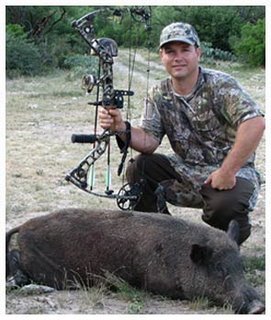 Texas trophy boar hunting goes year round for both feral hogs as well as Russian boars. Since these animals reproduce at a terrific rate and are almost free from any type of natural predator there is no need to worry about managing the size of the herd other than by harvesting too many older sows during any one year. Typically all litters are born about 1 to 1 ratio of males to females, leaving a lot of options for Texas trophy boar hunting without impacting the breeding population.
Texas trophy boar hunting goes year round for both feral hogs as well as Russian boars. Since these animals reproduce at a terrific rate and are almost free from any type of natural predator there is no need to worry about managing the size of the herd other than by harvesting too many older sows during any one year. Typically all litters are born about 1 to 1 ratio of males to females, leaving a lot of options for Texas trophy boar hunting without impacting the breeding population.Regular harvesting of the older and younger boars on the Escondido Ranch keeps all the hogs in better shape since there is less competition between boars during the breeding season.
Can Texas trophy boar hunting animals be used for meat?
Yes, feral hogs, especially the younger hogs, provide great meat that is almost the same as domestic pork. There are many different recipes for wild hogs including making sausages and ground pork, roasts, stews and of course great pork ribs for the barbeque.
Labels: russian boar hunting, texas feral hog hunts, wild boar hunts, wild hog recipes
Archives
December 2008 January 2009 February 2009 April 2009 May 2009 June 2009 July 2009 August 2009 September 2009 November 2009 December 2009 January 2010 February 2010 March 2010 April 2010
Subscribe to Posts [Atom]
